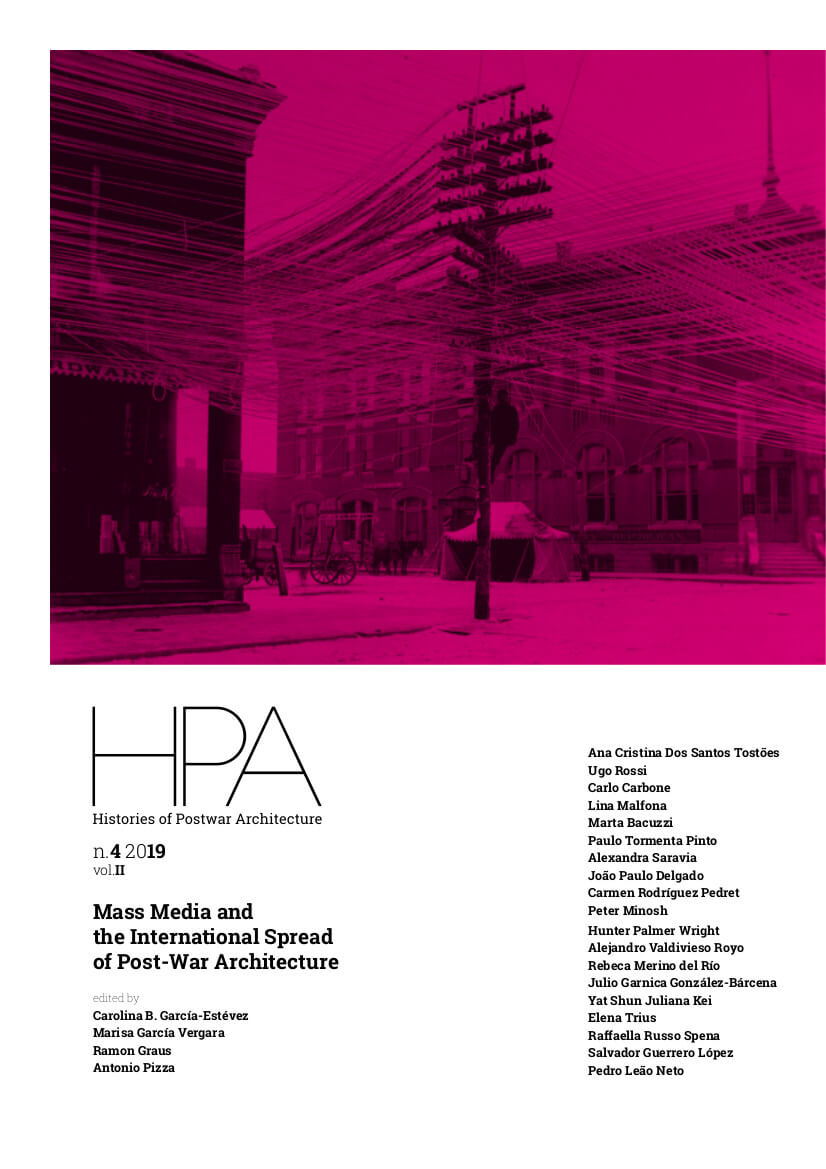Built in USA: Post-War Architecture-Midcentury Architecture as a Vehicle for American Foreign Policy
DOI:
https://doi.org/10.6092/issn.2611-0075/9679Keywords:
Media, Post-War Architecture, Cold-War, Politics, Museum of Modern ArtAbstract
This article considers the 1953 Museum of Modern Art exhibitionBuilt in USA: Post-War Architecturein relation to American diplomacy during the Cold War. By examining the international circulation of Built in USAby both governmental and cultural sector institution, we situate American postwar architecture within the informational agendas of a broader ideological struggle. We consider the engagement of media – image circulation and administrative apparatuses – with geopolitical forces and show the way in which architecture, in its status as a form of media, recursively negotiated them.
Downloads
References
Abel, Elie. “Rumanians Flock to U.S. Exhibition.” New York Times, February 16, 1958.
Bleecker, Samuel E. The Politics of Architecture: A Perspective on Nelson A. Rockefel-ler. New York: Rutledge Press, 1981.
Crozier, Michel. The Bureaucratic Phenomenon. Chicago: University of Chicago Press, 1964.
Cull, Nicholas John. The Cold War and the United States Information Agency: American Propaganda and Public Diplomacy, 1945-1989. Cambridge; New York: Cam-bridge University Press, 2008.
Drexler, Arthur. “Post-War Architecture.” In Built in USA: Post-War Architecture, edit-ed by Henry-Russell Hitchcock and Arthur Drexler. New York: Distributed by Simon & Schuster, 1952.
Fine, Herbert A., Ruth Harris, and William F. Sanford, Jr., eds. Foreign Relations of the United States, 1955-1957. Foreign Economic Policy; Foreign Information Pro-gram. Vol. IX. Washington D.C.: United States Government Printing Office, 1987.
Franc, Helen M. “The Early Years of the International Program and Council.” In The Museum of Modern Art at Mid-Century: At Home and Abroad, edited by John Szarkowski, Michael Kimmelman, Lynn Zevlansky, Hellen M. Franc, Terrence Riley, and Edward Eigen. New York: The Museum of Modern Art: Distributed by H.N. Abrams, 1994.
Hitchcock, Henry Russell. “The Architecture of Bureaucracy and the Architecture of Genius.” Architectural Review 101 (January 1947): 3–6.
Hitchcock, Henry-Russell. “Introduction.” In Built in USA: Post-War Architecture, edit-ed by Henry-Russell Hitchcock and Arthur Drexler. New York: Distributed by Simon & Schuster, 1952.
Hitchcock, Henry-Russell, and Arthur Drexler, eds. Built in USA: Post-War Architec-ture. New York: Distributed by Simon & Schuster, 1952.
Johnson, Phillip. “Preface.” In Built in USA: Post-War Architecture, edited by Henry-Russell Hitchcock and Arthur Drexler. New York: Distributed by Simon & Schuster, 1952.
Martin, Reinhold. The Organizational Complex: Architecture, Media, and Corporate Space. Cambridge: MIT Press, 2003.
Martin, Reinhold. Utopia’s Ghost: Architecture and Postmodernism, Again. Minneapolis: Univer-sity of Minnesota Press, 2010.
Rivas, Darlene. Missionary Capitalist Nelson Rockefeller in Venezuela. The Luther Hartwell Hodges Series on Business, Society, and the State. Chapel Hill: Univer-sity of North Carolina Press, 2002.
Saunders, Frances Stonor. The Cultural Cold War: The CIA and the World of Arts and Letters. New York: New Press, 1999.
Tafuri, Manfredo, and Francesco Dal Co. Modern Architecture. Translated by Robert Erich Wolf. New York: Electa/Rizzoli, 1986.
Turner, Fred. The Democratic Surround: Multimedia & American Liberalism from World War II to the Psychedelic Sixties. London: The University of Chicago Press, 2013.
Westad, Odd Arne. The Global Cold War: Third World Interventions and the Making of Our Times. Cambridge: Cambridge University Press, 2007.
Downloads
Published
How to Cite
Issue
Section
License
Copyright (c) 2019 Peter Minosh, Hunter Palmer
The copyrights of all the texts on this journal belong to the respective authors without restrictions. Authors grant to the journal a non-exclusive right to publish their work.
This journal is licensed under a Creative Commons Attribution 4.0 International License (full legal code).
See also our Open Access Policy.






